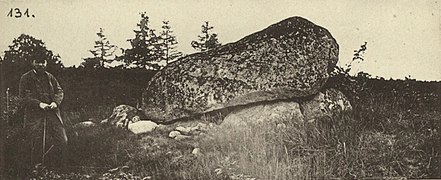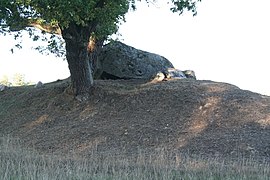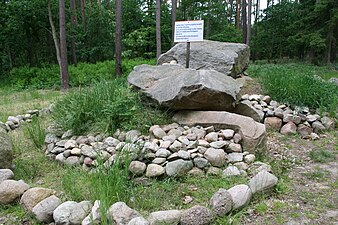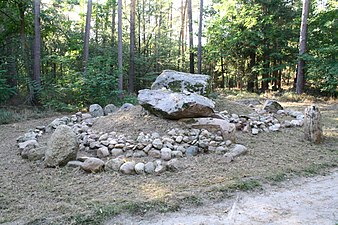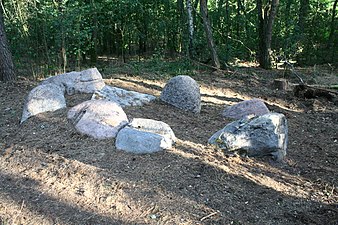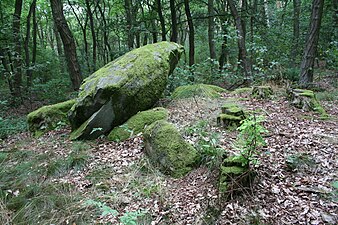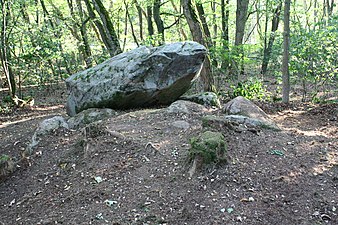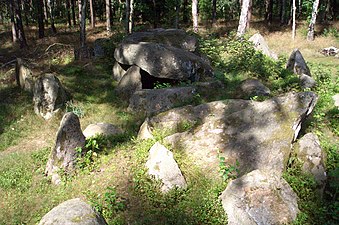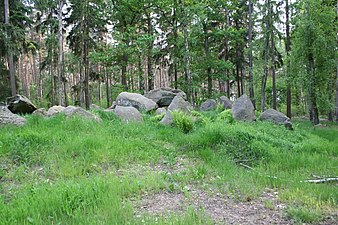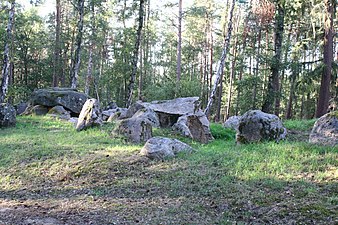Great stone graves near Lüdelsen
| Great stone graves near Lüdelsen | |||
|---|---|---|---|
|
Lüdelsen large stone grave 6 |
|||
|
|||
| Coordinates | Lüdelsen 1 , Lüdelsen 2 , Lüdelsen 3 , Lüdelsen 4 , Lüdelsen 5 , Lüdelsen 6 | ||
| place | Jübar , Saxony-Anhalt , Germany | ||
| Emergence | 3700 to 3350 BC Chr. | ||
The megalithic graves near Lüdelsen are a group of six more or less preserved megalithic tombs from the Neolithic deep-engraving ceramic culture near Lüdelsen , a town in Jübar in the Altmark district of Salzwedel , Saxony-Anhalt . Two other graves were destroyed in the 19th century. Possibly there was a ninth grave, which the field name "at the great stone" could indicate.
location
The plants at Lüdelsen originally formed three groups. The first is located in a forest about 2.1 km east of the center of Lüdelsen, north of the road to Stöckheim . This group describes a line about 200 m long and consists of appendices 1 to 5. Of these graves, No. 1 is the easternmost. About 70 m west-southwest of this is grave 5. Another 40 m west is grave 4. Grave 3 is about 45 m west and grave 2 40 m south-southwest of this. Annex 6 (the so-called royal tomb) is located about 800 m west of this group. South of the road were the two destroyed graves close together.
There are several other large stone graves in the vicinity. 1.8 km east-northeast of grave 1 is the large stone grave Stöckheim and 3.2 km west-northwest of grave 6 are the large stone graves near Bornsen . Several other graves, destroyed in the 19th century, were to the east near Nieps , Ahlum and Rohrberg .
Research history
The graves were first described in 1843 by Johann Friedrich Danneil . At the beginning of the 1890s, Eduard Krause and Otto Schoetensack discovered that the two southern structures had been destroyed in the meantime when the Altmark stone graves were taken again. Since 1972 the graves that have been preserved have been cleaned and freed of vegetation annually by the association “Young Archaeologists of the Altmark”. In 2003-04, all remaining large stone graves in the Altmark were recorded and measured as a joint project of the State Office for Monument Preservation and Archeology of Saxony-Anhalt , the Johann Friedrich Danneil Museum in Salzwedel and the association “Young Archaeologists of the Altmark”. This was followed by an excavation project of the Christian-Albrechts-Universität Kiel , in which two large stone graves near Lüdelsen were archaeologically examined under the direction of Denis Demnick , first in 2007 grave 3 and then in 2009 and 2010 grave 6. Since May 2011 all graves have been included Lüdelsen stations on a historical-archaeological hiking trail. For this purpose, the systems were again thoroughly cleaned and provided with information boards.
For some of the graves there are numbers that differ from the official count. For the two destroyed graves, the numbers that Krause and Schoetensack gave them are used below (KS 135 and KS 136 for short).
| official no. | Danneil (1843) | Krause / Schoetensack (1893) |
Beier (1991) | Remarks |
|---|---|---|---|---|
| 1 | D 94 | 131 | 1 | |
| 2 | D 96 | 133 | 3 | |
| 3 | - | - | 4th | |
| 4th | D 95 | 132 | 2 | |
| 5 | D 97 | 134 | 5 | |
| 6th | D 100 | 137 | 8th | |
| - | D 98 | 135 | 6th | destroyed |
| - | D 99 | 136 | 7th | destroyed |
description
Preserved graves
Grave 1
Grave 1 is one of the southernmost polygonal towers . It is located on a hill measuring 1.8 m from the south and 0.8 m from the north. Its edges are plowed, which gives it a pointed oval shape. The grave originally had eight wall stones, six of which are still preserved. The capstone has the dimensions 2.9 m × 2.2 m × 1.0 m. A number of bowls have been sunk into the capstone . A grave border (barn bed) probably never existed. The burial chamber measures 2.5 m × 1.2 m and has a visible height of 0.6 m. The polygonal dolmen is a subspecies of the dolmen that occurs particularly in Denmark , Sweden and Schleswig-Holstein . Only individual specimens are known from Mecklenburg-Western Pomerania ( Lexow ) and Saxony-Anhalt .
The grave is in the middle of a field and is surrounded by a group of trees.
Grave 2
Grave 2 is a large dolmen . It sits on a slope that slopes southwards and has been badly damaged by the construction of the nearby road. The elongated hill on which it lies was partly filled up and partly deepened. The edging has an east-west orientation. Today there are still eleven curbs, the distribution of which suggests an oval edging with a width of 8.5 m. The original length can no longer be determined.
Like the border, the grave is oriented east-west and today consists of two broken capstones and six wall stones. The eastern and larger of the two capstones measures 2.7 m × 1.9 m × 1.1 m. On its south side there are about eleven bowls. The burial chamber is badly damaged by fallen cap stones. It is rectangular, 1.6 m wide and at least 3.5 m long. The funeral has probably been excluded.
Grave 3
Thanks to the 2007 excavation, grave 3 is one of the best-researched large stone graves in the Altmark. It belongs to the extended dolmen type and is located on a southern slope. Before the excavations began, only two cover stones and two wall stones as well as the mound of about 10 m in diameter were visible. The grave is oriented west-northwest-east-southeast.
The excavation revealed that the mound was poured in two phases. The diameter of the second, larger mound was determined to be about 30 m. It was also possible to identify borders that consist of at least two stone circles. The inner one could clearly be reconstructed. It consists of 10–40 cm large field stones that were laid in two or three layers on top of each other. The inner mound ends at the stone circle. An outer row of larger stones is only partially preserved. Its original form is unclear.
In the area of the chamber, more bearing stones came to light during the excavation. The outside of the chamber measures 4.2 mx 2.6 m and consists of seven bearing stones on which two cap stones rest. Two more bearing stones in the east form the entrance, which bends to the north.
In the burial chamber, shattered pottery and flint artefacts were found that belong to different cultures and suggest a long period of use. The funnel beaker culture (4200–2800 BC), the spherical amphora culture (3100–2700 BC) and the single grave culture (2800–2100 BC) are represented. One of the subsequent burials could be assigned to corded ceramics (2800–2200 BC). Ceramic finds in front of the chamber prove that the facility was used until the Iron Age .
Grave 4
Grave 4 is a large dolmen and lies on a slight southern slope. Neither a hill nor a grave border are recognizable. The grave originally consisted of eight wall stones and three cap stones. One wall stone and two cap stones are no longer available today. The burial chamber is oriented east-west, rectangular or trapezoidal and has the internal dimensions 3.3 m × 1.4 m. The remaining capstone measures 1.8 m × 1.1 m. The north-western wall stone has a noticeable, deep channel, but it was probably created naturally.
Grave 5
Grave 5 is also a large dolmen. Like grave 4, it is on a slight southern slope. The burial mound is oriented northwest-southeast, heavily eroded and still reaches a maximum height of about 0.6 m. An enclosure cannot be clearly proven, but a stone in the vicinity of the grave could indicate its former existence. The grave originally consisted of eight wall stones and three cap stones. Two wall stones and two cap stones are no longer available. The burial chamber is oriented northwest-southeast, rectangular and has the internal dimensions 2.5 m × 1.4 m. The remaining capstone measures 2.2 m × 1.5 m × 0.8 m and, in addition to natural depressions, has at least three artificial bowls on its surface.
Grave 6 ("royal grave")
Grave 6 is the largest grave in Lüdelsen and is one of the largest and best preserved large stone graves in the Altmark, which is why it is popularly referred to as the “royal grave”. It belongs to the type of passage graves . The entire system is oriented east-west. The enclosure is trapezoidal and originally consisted of around 60 stones, 50 of which have survived. It has a total length of 35.1 m and a width between 5.8 m and 8.5 m. It is constricted in the middle. The enclosure has four corner stones (so-called " guardian stones "), the two western ones are in front of the enclosure. Three of them and five other stones fell over. All of the edging stones are exceptionally large. For example, the eastern guards measure 2.5 m × 0.9 m and 2.0 m × 1.7 m × 1.0 m and the south-western watchman 2.7 m × 1.6 m.
The elongated burial mound is located inside the enclosure and reaches a maximum height of 1.7 m in its eastern part, while it reaches 1.2 m in the middle. The rectangular burial chamber has the internal dimensions of 7.9 m × 1.7 m and a height of 1.1 m. It is surrounded by 15 wall stones, another one has not survived. All five capstones are present, but two middle ones have collapsed. The largest capstone measures 2.2 m × 1.9 m × 0.8 m. The entrance was probably on the south side of the burial chamber. However, this can only be recognized by the fact that there is a gap at this point both between the wall stones and between the edging stones.
Grave 6 was the subject of excavations by the Christian Albrechts University Kiel between 2009 and 2010.
Destroyed graves
Grave KS 135
Grave KS 135 was probably an extended dolmen. The burial chamber had a length of about 3.1 m and a width of about 1.9 m.
Grave KS 136
Grave KS 136 is probably also an enlarged dolmen. The dimensions of the burial chamber were probably identical to those of KS 135.
See also
literature
- Hans-Jürgen Beier : The megalithic, submegalithic and pseudomegalithic buildings as well as the menhirs between the Baltic Sea and the Thuringian Forest. Contributions to the prehistory and early history of Central Europe 1. Wilkau-Haßlau 1991, ISBN 978-3-930036-00-4 .
- Wilhelm Blasius : Guide to the megalithic grave monuments in the western part of the Salzwedel district. In: Thirty-first annual report of the Altmark Association for Patriotic History and Industry. Issue 2, 1904, pp. 104-106 ( PDF; 8.1 MB ).
- Hartmut Bock , Barbara Fritsch, Lothar Mittag: Great stone graves of the Altmark . State Office for Monument Preservation and Archeology Saxony-Anhalt and State Museum for Prehistory, Halle (Saale) 2006, ISBN 3-939414-03-4 , pp. 114–125.
- Johann Friedrich Danneil : Special evidence of the barrows in the Altmark . In: Sixth annual report of the Altmark Association for Patriotic History and Industry . 1843, pp. 86-122 ( PDF; 5.5 MB ).
- Denis Demnick: Visibility analyzes using the example of megalithic graves from the Altmark . In: Hans-Jürgen Beier et al. (Ed.): Neolithic monuments and Neolithic societies. Varia neolithica VI (= contributions to the prehistory and early history of Central Europe. Volume 56). Verlag Beier & Beran, Langenweißbach 2009, ISBN 978-3-941171-28-2 , pp. 145-156.
- Denis Demnick et al .: The Großdolmen Lüdelsen 3 in the western Altmark (Saxony-Anhalt). Building history, rituals and landscape reconstruction . In: www.jungsteinsite.de - Article from December 15, 2008 ( PDF; 4.65 MB ).
- Denis Demnick et al .: The large stone grave Lüdelsen 3 in the western Altmark (Saxony-Anhalt). Preliminary report on the 2007 excavation and the pollen profile in the Beetzendorfer Bruch. With contributions by A. Beyer, J.-P. Brozio, E. Erkul, H. Kroll, and E. Tafel. In: Annual publication for Central German prehistory. Vol. 92, 2008 (2011), pp. 231-308.
- Denis Demnick et al .: Determining the use of space. - Great stone graves of the Altmark. In: Archeology in Germany. Issue 4/2009, 2009, pp. 34–39.
- Sarah Diers: Western Altmark versus Flintbek - An attempt to quantify and qualify human impact on landscape within funnel beaker societies. In: Quarternary International. Volume 279-280, 2012, p. 117.
- Sarah Diers: Human-environmental relationships between 4000 and 2200 cal BC Vegetation-historical studies on moors and funnel-shaped sites in the Altmark (= early monumentality and social differentiation. Volume 15). Rudolf Habelt, Bonn 2018, ISBN 978-3-7749-4130-4 ( online ).
- Sarah Diers, Denis Demnick: Megalithic landscape in the western Altmark: Middle Neolithic settlement patterns of a small region with large stone complexes . In: Harald Meller (ed.): Dug up - cooperation projects in Saxony-Anhalt. Conference from 17 to 20 May 2009 in the State Museum for Prehistory Halle (Saale) (= Archeology in Saxony-Anhalt. Special volume 16). State Office for Monument Preservation and Archeology Saxony-Anhalt and State Museum for Prehistory, Halle (Saale) 2012, ISBN 978-3-939414-63-6 , pp. 49–56.
- Sarah Diers: et al .: Altmark megalithic landscape - a new project on megalithic graves and settlement patterns in the Altmark. In: Hans-Jürgen Beier et al. (Ed.): Neolithic monuments and Neolithic societies. Varia neolithica VI (= contributions to the prehistory and early history of Central Europe. Volume 56). Verlag Beier & Beran, Langenweißbach 2009, ISBN 978-3-941171-28-2 , pp. 65-71.
- Sarah Diers et al .: The Western Altmark versus Flintbek - palaeoecological research on two megalithic regions. In: Journal of Archaeological Science. Volume 41, 2014, pp. 185-198 ( online ).
- Doris Jansen, Oliver Nelle: The Neolithic woodland - archaeoanthracology of six Funnel Beaker sites in the lowlands of Germany. In: Journal of Archaeological Science. Volume 51, 2014, pp. 154–163 ( online )
- Hans-Ulrich Kelch: Mysterious pans. In: Hartmut Bock (Ed.): Cities - Villages - Friedhöfe. Archeology in the Altmark 2: From the High Middle Ages to the modern age (= contributions to the cultural history of the Altmark and its peripheral areas, Volume 8). Oschersleben 2002, ISBN 3-935358-36-9 , pp. 458-469.
- Eduard Krause , Otto Schoetensack : The megalithic graves (stone chamber graves) of Germany . I .: Altmark . In: Journal of Ethnology . Vol. 25, 1893, p. 153 / no. 131-134 et al. 137, Plate VI / 131-133 and 137, VII / 131-133 et al. 137, IX / 131 ( PDF; 39.0 MB ).
- Johannes Müller : Occupy Time! The construction of design and monuments in Tiefstich central Europe. In: Kristian Brink et al .: Neolithic diversities. Perspectives from a conference in Lund, Sweden (= Acta Archaeologica Lundensia. Volume 65). Department of Archeology and Ancient History, Lund 2015, ISBN 978-91-89578-60-9 , pp. 153-163 ( online ).
- Britta Schulze-Thulin : Large stone graves and menhirs. Saxony-Anhalt • Thuringia • Saxony . Mitteldeutscher Verlag, Halle (Saale) 2007, ISBN 978-3-89812-428-7 , pp. 45-46.
Web links
- megalithic.co.uk: grave 1 , grave 2 , grave 3 , grave 4 , grave 5 , grave 6
- kleks-online.de: grave 1 , grave 2 , grave 3 , grave 4 , grave 5 , grave 6
- grosssteingraeber.de: Grave 1 , Grave 2 , Grave 3 , Grave 4 , Grave 5 , Grave 6
- strahlen.org: grave 1 , grave 2 , grave 3 , grave 4 , grave 5 , grave 6
- DFG ScienceTV - At the King's Grave
- State Museum of Prehistory - Find of the Month, May 2011: May: Hiking between the barrows - the new archaeological-historical hiking trail in Lüdelsen
Individual evidence
- ↑ Beier 1991. Catalog, p. 52.
- ↑ Hartmut Bock, Barbara Fritsch, Lothar Mittag: Großsteingraves der Altmark. 2006, pp. 116-118.
- ↑ Demnick et al. 2008, pp. 2-3.
- ↑ Krause / Schoetensack 1893, p. 153.
- ↑ Hartmut Bock: Student working groups and ground monument preservation in the north-western Altmark. In: Annual publication for Central German prehistory. Volume 69, 1986, p. 285 ( online ).
- ^ Young archaeologists of the Altmark eV - On the history of the association .
- ↑ Hartmut Bock, Barbara Fritsch, Lothar Mittag: Großsteingraves der Altmark. 2006, p. 11.
- ↑ State Museum of Prehistory - Find of the Month, May 2011: May: Hiking between megalithic tombs - the new archaeological-historical hiking trail in Lüdelsen
- ↑ a b Hartmut Bock, Barbara Fritsch, Lothar Mittag: Großsteingräber der Altmark. 2006, p. 114.
- ↑ a b Hartmut Bock, Barbara Fritsch, Lothar Mittag: Großsteingräber der Altmark. 2006, p. 116.
- ↑ Diers, Demnick, Fritsch & Müller, pp. 65f.
- ↑ Demnick et al., Pp. 12-14.
- ↑ Demnick et al., Pp. 7-12.
- ↑ Demnick et al., Pp. 17-19
- ↑ Demnick et al., Pp. 21-24.
- ↑ Demnick et al., Pp. 25-31.
- ↑ Hartmut Bock, Barbara Fritsch, Lothar Mittag: Großsteingraves der Altmark. 2006, p. 118.
- ↑ Hartmut Bock, Barbara Fritsch, Lothar Mittag: Großsteingraves der Altmark. 2006, p. 119.
- ↑ Hartmut Bock, Barbara Fritsch, Lothar Mittag: Großsteingraves der Altmark. 2006, pp. 120-121.
- ↑ Hartmut Bock, Barbara Fritsch, Lothar Mittag: Großsteingraves der Altmark. 2006, p. 121.
- ↑ The large stone grave Lüdelsen 6 near Salzwedel
- ↑ a b Krause / Schoetensack 1893, p. 153.



